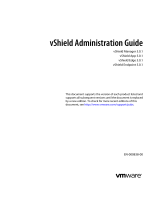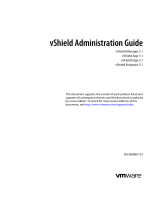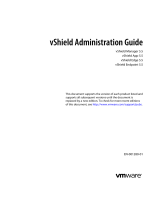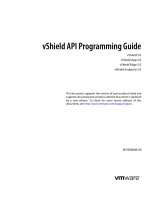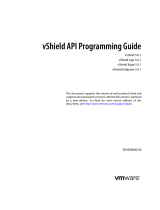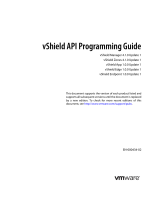Page is loading ...

vShield Administration Guide
vShield Manager 5.0
vShield App 5.0
vShield Edge 5.0
vShield Endpoint 5.0
This document supports the version of each product listed and
supports all subsequent versions until the document is replaced
by a new edition. To check for more recent editions of this
document, see http://www.vmware.com/support/pubs.
EN-000694-01

vShield Administration Guide
2 VMware, Inc.
You can find the most up-to-date technical documentation on the VMware Web site at:
http://www.vmware.com/support/
The VMware Web site also provides the latest product updates.
If you have comments about this documentation, submit your feedback to:
Copyright
©
2010, 2011 VMware, Inc. All rights reserved. This product is protected by U.S. and international copyright and
intellectual property laws. VMware products are covered by one or more patents listed at
http://www.vmware.com/go/patents.
VMware is a registered trademark or trademark of VMware, Inc. in the United States and/or other jurisdictions. All other marks
and names mentioned herein may be trademarks of their respective companies.
VMware, Inc.
3401 Hillview Ave.
Palo Alto, CA 94304
www.vmware.com

Contents
About This Book 7
1
Overview of vShield 9
About vShield Components 9
Migration of vShield Components 11
About VMware Tools on vShield Components 11
Ports Required for vShield Communication 11
2
vShield Manager User Interface Basics 13
Log in to the vShield Manager User Interface 13
About the vShield Manager User Interface 14
3
Management System Settings 17
Connect to Your vCenter Server 17
Register the vShield Manager as a vSphere Client Plug-In 18
Identify DNS Services 18
Set the vShield Manager Date and Time 19
Download a Technical Support Log from a Component 19
View vShield Manager Status 19
Add an SSL Certificate to Identify the vShield Manager Web Service 20
4
User Management 21
Managing User Accounts 21
Managing the Default User Account 22
Add a User Account 22
Edit a User Account 23
Change a User Role 23
Disable or Enable a User Account 24
Delete a User Account 24
5
Updating System Software 25
View the Current System Software 25
Upload an Update 25
6
Backing Up vShield Manager Data 27
Back Up Your vShield Manager Data on Demand 27
Schedule a Backup of vShield Manager Data 28
Restore a Backup 29
7
System Events and Audit Logs 31
View the System Event Report 31
VMware, Inc.
3

vShield Manager Virtual Appliance Events 31
vShield App Events 32
About the Syslog Format 33
View the Audit Log 33
8
vShield Edge Management 35
View the Status of a vShield Edge 35
Specify a Remote Syslog Server 36
Managing the vShield Edge Firewall 36
Managing NAT Rules 40
Managing DHCP Service 41
Managing VPN Service 42
Add a Static Route 45
Manage Load Balancer Service 45
Start or Stop vShield Edge Services 46
Upgrade vShield Edge Software 46
Re-deploy vShield Edge 47
9
vShield App Management 49
Send vShield App System Events to a Syslog Server 49
View the Current System Status of a vShield App 50
10
vShield App Flow Monitoring 51
Understanding the Flow Monitoring Display 51
Change the Date Range of the Flow Monitoring Charts 52
View a Specific Application in the Flow Monitoring Charts 52
View the Flow Monitoring Report 53
Delete All Recorded Flows 54
11
vShield App Firewall Management 55
Using App Firewall 55
Working with Applications 57
Grouping Objects 58
Working with Application Firewall Rules 59
Using SpoofGuard 61
12
vShield Endpoint Events and Alarms 65
View vShield Endpoint Status 65
vShield Endpoint Alarms 66
vShield Endpoint Events 66
vShield Endpoint Audit Messages 67
13
vShield Data Security Management 69
vShield Data Security User Roles 69
Defining a Data Security Policy 70
Editing a Data Security Policy 72
Running a Data Security Scan 72
Analyzing Results 73
vShield Administration Guide
4 VMware, Inc.

Creating Regular Expressions 74
Available Regulations 75
Available Content Blades 90
Supported File Formats 109
14
Troubleshooting 115
Troubleshoot vShield Manager Installation 115
Troubleshooting Operational Issues 116
Troubleshooting vShield Edge Issues 117
Troubleshoot vShield Endpoint Issues 119
Troubleshooting vShield Data Security Issues 120
Index 123
Contents
VMware, Inc. 5

vShield Administration Guide
6 VMware, Inc.

About This Book
This manual, the vShield Administration Guide, describes how to install, configure, monitor, and maintain the
VMware
®
vShield™ system by using the vShield Manager user interface, the vSphere Client plug-in, and
command line interface (CLI). The information includes step-by-step configuration instructions, and suggested
best practices.
Intended Audience
This manual is intended for anyone who wants to install or use vShield in a VMware vCenter environment.
The information in this manual is written for experienced system administrators who are familiar with virtual
machine technology and virtual datacenter operations. This manual assumes familiarity with VMware
Infrastructure 4.x, including VMware ESX, vCenter Server, and the vSphere Client.
VMware Technical Publications Glossary
VMware Technical Publications provides a glossary of terms that might be unfamiliar to you. For definitions
of terms as they are used in VMware technical documentation, go to http://www.vmware.com/support/pubs.
Document Feedback
VMware welcomes your suggestions for improving our documentation. If you have comments, send your
feedback to [email protected].
Technical Support and Education Resources
The following technical support resources are available to you. To access the current version of this book and
other books, go to http://www.vmware.com/support/pubs.
Online and Telephone
Support
To use online support to submit technical support requests, view your product
and contract information, and register your products, go to
http://www.vmware.com/support.
Customers with appropriate support contracts should use telephone support
for the fastest response on priority 1 issues. Go to
http://www.vmware.com/support/phone_support.html.
Support Offerings
To find out how VMware support offerings can help meet your business needs,
go to http://www.vmware.com/support/services.
VMware Professional
Services
VMware Education Services courses offer extensive hands-on labs, case study
examples, and course materials designed to be used as on-the-job reference
tools. Courses are available onsite, in the classroom, and live online. For onsite
pilot programs and implementation best practices, VMware Consulting
VMware, Inc. 7

Overview of vShield 1
VMware
®
vShield is a suite of security virtual appliances built for VMware vCenter Server and VMware ESX
integration. vShield is a critical security component for protecting virtualized datacenters from attacks and
misuse helping you achieve your compliance-mandated goals.
This guide assumes you have administrator access to the entire vShield system. The viewable resources in the
vShield Manager user interface can differ based on the assigned role and rights of a user, and licensing. If you
are unable to access a screen or perform a particular task, consult your vShield administrator.
n
About vShield Components on page 9
vShield includes components and services essential for protecting virtual machines. vShield can be
configured through a web-based user interface, a vSphere Client plug-in, a command line interface (CLI),
and REST API.
n
Migration of vShield Components on page 11
The vShield Manager and vShield Edge virtual appliances can be automatically or manually migrated
based on DRS and HA policies. The vShield Manager must always be up, so you must migrate the vShield
Manager whenever the current ESX host undergoes a reboot or maintenance mode routine.
n
About VMware Tools on vShield Components on page 11
Each vShield virtual appliance includes VMware Tools. Do not upgrade or uninstall the version of
VMware Tools included with a vShield virtual appliance.
n
Ports Required for vShield Communication on page 11
About vShield Components
vShield includes components and services essential for protecting virtual machines. vShield can be configured
through a web-based user interface, a vSphere Client plug-in, a command line interface (CLI), and REST API.
To run vShield, you need one vShield Manager virtual machine and at least one vShield App or vShield Edge
module.
vShield Manager
The vShield Manager is the centralized network management component of vShield and is installed from OVA
as a virtual machine by using the vSphere Client. Using the vShield Manager user interface, administrators
install, configure, and maintain vShield components. A vShield Manager can run on a different ESX host from
your vShield App and vShield Edge modules.
The vShield Manager leverages the VMware Infrastructure SDK to display a copy of the vSphere Client
inventory panel.
For more on the using the vShield Manager user interface, see Chapter 2, “vShield Manager User Interface
Basics,” on page 13.
VMware, Inc.
9

vShield Edge
vShield Edge provides network edge security and gateway services to isolate the virtual machines in a port
group, vDS port group, or Cisco
®
Nexus 1000V. The vShield Edge connects isolated, stub networks to shared
(uplink) networks by providing common gateway services such as DHCP, VPN, NAT, and Load Balancing.
Common deployments of vShield Edge include in the DMZ, VPN Extranets, and multi-tenant Cloud
environments where the vShield Edge provides perimeter security for Virtual Datacenters (VDCs).
NOTE You must obtain an evaluation or full license to use vShield Edge.
Standard vShield Edge
Services (Including
Cloud Director)
n
Firewall: Supported rules include IP 5-tuple configuration with IP and port
ranges for stateful inspection for TCP, UDP, and ICMP.
n
Network Address Translation: Separate controls for Source and
Destination IP addresses, as well as TCP and UDP port translation.
n
Dynamic Host Configuration Protocol (DHCP): Configuration of IP pools,
gateways, DNS servers, and search domains.
Advanced vShield Edge
Services
n
Site-to-Site Virtual Private Network (VPN): Uses standardized IPsec
protocol settings to interoperate with all major firewall vendors.
n
Load Balancing: Simple and dynamically configurable virtual IP addresses
and server groups.
vShield Edge supports syslog export for all services to remote servers.
vShield App
vShield App is an interior, vNIC-level firewall that allows you to create access control policies regardless of
network topology. A vShield App monitors all traffic in and out of an ESX host, including between virtual
machines in the same port group. vShield App includes traffic analysis and container-based policy creation.
vShield App installs as a hypervisor module and firewall service virtual appliance. vShield App integrates
with ESX hosts through VMsafe APIs and works with VMware vSphere platform features such as DRS,
vMotion, DPM, and maintenance mode.
vShield App provides firewalling between virtual machines by placing a firewall filter on every virtual network
adapter. The firewall filter operates transparently and does not require network changes or modification of IP
addresses to create security zones. You can write access rules by using vCenter containers, like datacenters,
cluster, resource pools and vApps, or network objects, like Port Groups and VLANs, to reduce the number of
firewall rules and make the rules easier to track.
You should install vShield App instances on all ESX hosts within a cluster so that VMware vMotion™
operations work and virtual machines remain protected as they migrate between ESX hosts. By default, a
vShield App virtual appliance cannot be moved by using vMotion.
The Flow Monitoring feature displays allowed and blocked network flows at the application protocol level.
You can use this information to audit network traffic and troubleshoot operational.
NOTE You must obtain an evaluation or full license to use vShield App.
vShield Administration Guide
10 VMware, Inc.

vShield Endpoint
vShield Endpoint offloads antivirus and anti-malware agent processing to a dedicated secure virtual appliance
delivered by VMware partners. Since the secure virtual appliance (unlike a guest virtual machine) doesn't go
offline, it can continuously update antivirus signatures thereby giving uninterrupted protection to the virtual
machines on the host. Also, new virtual machines (or existing virtual machines that went offline) are
immediately protected with the most current antivirus signatures when they come online.
vShield Endpoint installs as a hypervisor module and security virtual appliance from a third-party antivirus
vendor (VMware partners) on an ESX host.
NOTE You must obtain an evaluation or full license to use vShield Endpoint.
vShield Data Security
vShield Data Security provides visibility into sensitive data stored within your organization's virtualized and
cloud environments. Based on the violations reported by vShield Data Security, you can ensure that sensitive
data is adequately protected and assess compliance with regulations around the world.
Migration of vShield Components
The vShield Manager and vShield Edge virtual appliances can be automatically or manually migrated based
on DRS and HA policies. The vShield Manager must always be up, so you must migrate the vShield Manager
whenever the current ESX host undergoes a reboot or maintenance mode routine.
Each vShield Edge should move with its secured port group to maintain security settings and services.
vShield App, vShield Endpoint, or vShield Data Security cannot be moved to another ESX host. If the ESX host
on which these components reside requires a manual maintenance mode operation, you must de-select the
Move powered off and suspended virtual machines to other hosts in the cluster check box to ensure these
virtual appliances are not migrated. These services restart after the ESX host comes online.
About VMware Tools on vShield Components
Each vShield virtual appliance includes VMware Tools. Do not upgrade or uninstall the version of VMware
Tools included with a vShield virtual appliance.
Ports Required for vShield Communication
The vShield Manager requires the following ports to be open:
n
Access to ESX hosts: 902/TCP and 903/TCP
n
REST API: 80/TCP and 443/TCP
n
Graphical User Interface: 80/TCP to 443/TCP and initiates connections to vSphere vCenter SDK.
n
SSH access to the CLI (not enabled by default): 22/TCP
Chapter 1 Overview of vShield
VMware, Inc. 11

vShield Administration Guide
12 VMware, Inc.

vShield Manager User Interface Basics 2
The vShield Manager user interface offers configuration and data viewing options specific to vShield use. By
utilizing the VMware Infrastructure SDK, the vShield Manager displays your vSphere Client inventory panel
for a complete view of your vCenter environment.
NOTE You can register the vShield Manager as a vSphere Client plug-in. This allows you to configure vShield
components from within the vSphere Client. For more, see “Register the vShield Manager as a vSphere Client
Plug-In,” on page 18.
n
Log in to the vShield Manager User Interface on page 13
You access the vShield Manager management interface by using a Web browser.
n
About the vShield Manager User Interface on page 14
The vShield Manager user interface is divided into two panels: the inventory panel and the configuration
panel. You select a view and a resource from the inventory panel to open the available details and
configuration options in the configuration panel.
Log in to the vShield Manager User Interface
You access the vShield Manager management interface by using a Web browser.
Procedure
1 Open a Web browser window and type the IP address assigned to the vShield Manager.
The vShield Manager user interface opens in an SSH session.
2 Accept the security certificate.
NOTE To use an SSL certificate for authentication, see “Add an SSL Certificate to Identify the vShield
Manager Web Service,” on page 20.
The vShield Manager login screen appears.
3 Log in to the vShield Manager user interface by using the username admin and the password default.
You should change the default password as one of your first tasks to prevent unauthorized use. See “Edit
a User Account,” on page 23.
4 Click Log In.
VMware, Inc.
13

About the vShield Manager User Interface
The vShield Manager user interface is divided into two panels: the inventory panel and the configuration panel.
You select a view and a resource from the inventory panel to open the available details and configuration
options in the configuration panel.
When clicked, each inventory object has a specific set of tabs that appear in the configuration panel.
n
vShield Manager Inventory Panel on page 14
The vShield Manager inventory panel hierarchy mimics the vSphere Client inventory hierarchy.
n
vShield Manager Configuration Panel on page 15
The vShield Manager configuration panel presents the settings that can be configured based on the
selected inventory resource and the output of vShield operation. Each resource offers multiple tabs, each
tab presenting information or configuration forms corresponding to the resource.
vShield Manager Inventory Panel
The vShield Manager inventory panel hierarchy mimics the vSphere Client inventory hierarchy.
Resources include the root folder, datacenters, clusters, port groups, ESX hosts, and virtual machines, including
your installed vShield App and vShield Edge modules. As a result, the vShield Manager maintains solidarity
with your vCenter Server inventory to present a complete view of your virtual deployment. The vShield
Manager is the only virtual machine that does not appear in the vShield Manager inventory panel. vShield
Manager settings are configured from the Settings & Reports resource atop the inventory panel.
The inventory panel offers multiple views: Hosts & Clusters, Networks, and Secured Port Groups. The Hosts
& Clusters view displays the datacenters, clusters, resource pools, and ESX hosts in your inventory. The
Networks view displays the VLAN networks and port groups in your inventory. The Secured Port Groups
view displays the port groups protected by vShield Edge instances. The Hosts & Clusters and Networks views
are consistent with the same views in the vSphere Client.
There are differences in the icons for virtual machines and vShield components between the vShield Manager
and the vSphere Client inventory panels. Custom icons are used to show the difference between vShield
components and virtual machines, and the difference between protected and unprotected virtual machines.
Table 2-1. vShield Virtual Machine Icons in the vShield Manager Inventory Panel
Icon Description
A powered on virtual machine that is protected by a vShield App.
A powered on virtual machine that is not protected by a vShield App.
n
Refreshing the Inventory Panel on page 15
To refresh the list of resources in the inventory panel, click
. The refresh action requests the latest
resource information from the vCenter Server. By default, the vShield Manager requests resource
information from the vCenter Server every five minutes.
n
Searching the Inventory Panel on page 15
To search the inventory panel for a specific resource, type a string in the field atop the vShield Manager
inventory panel and click .
vShield Administration Guide
14 VMware, Inc.

Refreshing the Inventory Panel
To refresh the list of resources in the inventory panel, click . The refresh action requests the latest resource
information from the vCenter Server. By default, the vShield Manager requests resource information from the
vCenter Server every five minutes.
Searching the Inventory Panel
To search the inventory panel for a specific resource, type a string in the field atop the vShield Manager
inventory panel and click .
vShield Manager Configuration Panel
The vShield Manager configuration panel presents the settings that can be configured based on the selected
inventory resource and the output of vShield operation. Each resource offers multiple tabs, each tab presenting
information or configuration forms corresponding to the resource.
Because each resource has a different purpose, some tabs are specific to certain resources. Also, some tabs have
a second level of options.
Chapter 2 vShield Manager User Interface Basics
VMware, Inc. 15

vShield Administration Guide
16 VMware, Inc.

Management System Settings 3
The vShield Manager requires communication with your vCenter Server and services such as DNS and NTP
to provide details on your VMware Infrastructure inventory.
This chapter includes the following topics:
n
“Connect to Your vCenter Server,” on page 17
n
“Register the vShield Manager as a vSphere Client Plug-In,” on page 18
n
“Identify DNS Services,” on page 18
n
“Set the vShield Manager Date and Time,” on page 19
n
“Download a Technical Support Log from a Component,” on page 19
n
“View vShield Manager Status,” on page 19
n
“Add an SSL Certificate to Identify the vShield Manager Web Service,” on page 20
Connect to Your vCenter Server
Connecting to your vCenter Server enables the vShield Manager to display your VMware Infrastructure
inventory.
Procedure
1 Log in to the vShield Manager.
Upon initial login, the vShield Manager opens to the Configuration > vCenter tab. If you have previously
configured the vCenter tab form, perform the following steps:
a Click the Settings & Reports from the vShield Manager inventory panel.
b Click the Configuration tab.
The vCenter screen appears.
2 Under vCenter Server Information, type the IP address of your vCenter Server in theServer IP
Address/Name field.
3 Type your vSphere Client login user name in the Administrator User Name field.
This user account must have administrator access.
4 Type the password associated with the user name in the Password field.
5 Click Save.
VMware, Inc.
17

The vShield Manager connects to the vCenter Server, logs on, and utilizes the VMware Infrastructure SDK to
populate the vShield Manager inventory panel. The inventory panel is presented on the left side of the screen.
This resource tree should match your VMware Infrastructure inventory panel. The vShield Manager does not
appear in the vShield Manager inventory panel.
Register the vShield Manager as a vSphere Client Plug-In
The vSphere Plug-in option lets you register the vShield Manager as a vSphere Client plug-in. After the plug-
in is registered, you can open the vShield Manager user interface from the vSphere Client.
Procedure
1 If you are logged in to the vSphere Client, log out.
2 Log in to the vShield Manager.
3 Click Settings & Reports from the vShield Manager inventory panel.
4 Click the Configuration tab.
The vCenter screen appears.
5 Under vSphere Plug-in, click Register.
Registration might take a few minutes.
6 Log in to the vSphere Client.
7 Select an ESX host.
8 Verify that vShield Install appears as a tab.
What to do next
You can install and configure vShield components from the vSphere Client.
Identify DNS Services
You must specify at least one DNS server during vShield Manager setup. The specified DNS servers appear
in the vShield Manager user interface.
In the vShield Manager user interface, you can specify up to three DNS servers that the vShield Manager can
use for IP address and host name resolution.
Procedure
1 Click Settings & Reports from the vShield Manager inventory panel.
2 Click the Configuration tab.
The vCenter screen appears.
3 Under DNS Servers, type an IP address in Primary DNS IP Address to identify the primary DNS server.
This server is checked first for all resolution requests.
4 (Optional) Type an IP address in the Secondary DNS IP Address field.
5 (Optional) Type an IP address in the Tertiary DNS IP Address field.
6 Click Save.
vShield Administration Guide
18 VMware, Inc.

Set the vShield Manager Date and Time
You can set the date, time, and time zone of the vShield Manager to timestamp events and data. You can also
specify a connection to an NTP server to establish a common network time.
Procedure
1 Click Settings & Reports from the vShield Manager inventory panel.
2 Click the Configuration tab.
3 Click Date/Time.
4 In the Date and Clock field, type the date and time in the format YYYY-MM-DD HH:MM:SS.
5 In the NTP Server field, type the IP address of your NTP server.
You can type the hostname of your NTP server if you have set up DNS service.
6 From the Time Zone drop-down menu, select the appropriate time zone.
7 Click Save.
Download a Technical Support Log from a Component
You can download the system log from a vShield component to your PC. A system log can be used to
troubleshoot operational issues.
Procedure
1 Click Settings & Reports from the vShield Manager inventory panel.
2 Click the Configuration tab.
3 Click Support.
4 Under Tech Support Log Download, click Initiate next to the appropriate component.
Once initiated, the log is generated and uploaded to the vShield Manager. This might take several seconds.
5 After the log is ready, click the Download link to download the log to your PC.
The log is compressed and has the proprietary file extension .blsl.
What to do next
You can open the log using a decompression utility by browsing for All Files in the directory where you saved
the file.
View vShield Manager Status
vShield Manager shows system resource utilization.
Procedure
1 Click Settings & Reports from the vShield Manager inventory panel.
2 Click the Configuration tab.
3 Click Status.
What to do next
See “View the Current System Software,” on page 25.
Chapter 3 Management System Settings
VMware, Inc. 19

Add an SSL Certificate to Identify the vShield Manager Web Service
You can generate or import an SSL certificate into the vShield Manager to authenticate the identity of the
vShield Manager web service and encrypt information sent to the vShield Manager web server. As a security
best practice, you should use the generate certificate option to generate a private key and public key, where
the private key is saved to the vShield Manager.
Procedure
1 Click Settings & Reports from the vShield Manager inventory panel.
2 Click the Configuration tab.
3 Click SSL Certificate.
4 Under Generate Certificate Signing Request, complete the form by filling in the following fields:
Option Action
Common Name
Enter the name that matches the site name. For example, if the IP address of
vShield Manager management interface is 192.168.1.10, enter
192.168.1.10.
Organization Unit
Enter the department in your company that is ordering the certificate.
Organization Name
Enter the full legal name of your company.
City Name
Enter the full name of the city in which your company resides.
State Name
Enter the full name of the state in which your company resides.
Country Code
Enter the two-digit code that represents your country. For example, the
United States is US.
Key Algorithm
Select the cryptographic algorithm to use from either DSA or RSA.
Key Size
Select the number of bits used in the selected algorithm.
5 Click Generate.
Import an SSL certificate
You can import a pre-existing SSL certificate for use by the vShield Manager.
Procedure
1 Click Settings & Reports from the vShield Manager inventory panel.
2 Click the Configuration tab.
3 Click SSL Certificate.
4 Under Import Signed Certificate, click Browse at Certificate File to find the file.
5 Select the type of certificate file from the Certificate Type drop-down list.
6 Click Apply.
The certificate is stored in the vShield Manager.
vShield Administration Guide
20 VMware, Inc.
/

